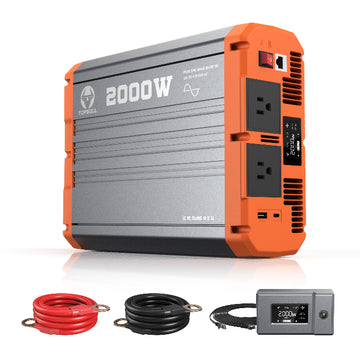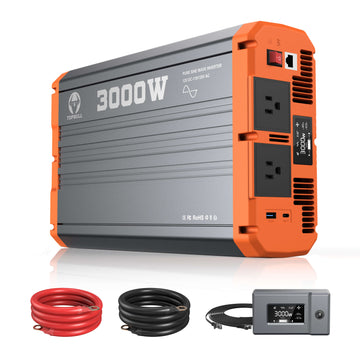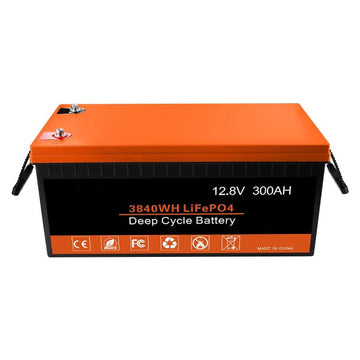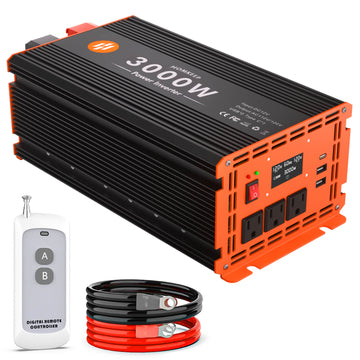A common choice for RVs, off-grid cabins, or emergency backup systems, the 2000 inverter is responsible for converting DC power into the AC power needed for household appliances. Batteries then serve to store the DC power, but how many batteries are required to meet our power needs? This article will give you the answer.
Factors affecting the number of batteries
When configuring batteries for a 2000W inverter, you must know that the number of batteries is not directly related to the power of the inverter but is determined by a number of factors.
1. Battery capacity
The capacity of a battery is measured in Ampere-hours (Ah) and directly determines how long the inverter will run. If you want the inverter to run longer, you will need a larger capacity battery, or you can increase the capacity by connecting several batteries in parallel.
2. Depth of discharge
Depth of discharge refers to the percentage of capacity that can be safely used by a battery and varies significantly between battery types. Traditional lead-acid batteries often have a depth of discharge of 50%. 100Ah lead-acid batteries can only provide 50Ah of effective capacity. Lithium batteries, on the other hand, have a discharge depth of 80%-95% and a cycle life of more than 2,000 cycles.
3. Battery voltage
The higher the battery voltage, the lower the current demand of the system. For the same load power and runtime, the system has a lower capacity requirement for multiple individual batteries. Simply put, a higher voltage system reduces the total number of cells compared to a lower voltage system.
For example, the system runs at 1500W for 4 hours, ignoring the loss of energy and the depth of discharge of the battery:
- 12V system: 1500W*4h/12V=500Ah; Using 12V 200Ah batteries, you need to connect 4 pieces in parallel
- 48V system: 1500W*4h/24V=125Ah; Under the 48V system, selecting 1 piece of 48V 200Ah batteries can satisfy.
4. Inverter efficiency
Inverters are not 100% efficient in their output; if the load requires 1200W of energy, the inverter must be outputting more than that, and the excess energy is lost as heat. The lower the efficiency, the more energy the batteries need to provide, and the number of batteries increases.
How many batteries does a 2000W inverter need?
Step 1: Calculating total energy requirements
First, you need to know how much energy the system needs from the batteries. The maximum load capacity of the inverter is known to be 2000W. Based on the running time of the load, you can calculate how much energy the battery needs to store to keep it running.
However, there is energy loss in the conversion process of the inverter, and some of the energy is dissipated as heat. The efficiency of an inverter is the ratio of the output energy to the input energy, usually 80%-95%.
Assuming you want your Topbull 12V 2000W inverter (95% efficiency) to power your refrigerator, lights, etc., for 2 hours during a power outage, the total demand is:
2000W*2h/0.95=4210Wh
The less efficient the inverter is, the more energy the battery needs to provide. So you can choose a good quality inverter to reduce the waste of electricity.

Step 2: Determine the capacity and number of individual batteries
In a 12V system, the total battery capacity (Ah)=4210Wh/12V=343(Ah)
Because batteries have a depth of discharge when in use and cannot be fully discharged, a certain amount of safety capacity should be left.
- For lead-acid batteries: 343(Ah)/0.5=686(Ah), for 12V 200Ah lead-acid batteries, at least 4 pieces are needed
- For lithium batteries: 343(Ah)/0.9=381(Ah), for 12V 200Ah lithium batteries, only two pieces are needed
Step 2: Calculate how much amperage a 2000W inverter draws
When configuring a battery pack for a 2000W inverter, the current requirement (amperage) is the central parameter in determining the battery capacity and cable size. The higher the current, the larger the cable cross-section needs to be to prevent overheating (e.g., 4/0 AWG cable for a 12V system, only 10 AWG for a 48V system).
Input current: 2000W/12V/0.95≈175A
Tips for choosing batteries for a 2000W inverter
When configuring a battery pack for a 2000W inverter, the choice of battery not only affects system performance but also has a direct bearing on safety, longevity, and long-term cost.
Battery types
Lead-acid and lithium batteries are the two most common types of batteries on the market. Lead-acid batteries are usually lower in cost and are suitable for scenarios with limited budgets and low frequency of use. However, lead-acid batteries have a much lower depth of discharge than lithium batteries, only 50%, and a cycle life of 300-500 cycles. In the long run, lead-acid batteries need to accept higher maintenance costs and shorter lifespans.
Lithium batteries are more costly, but with a longer cycle life and a depth of discharge of 90%, they are more cost-effective in the long run. It is suitable for scenarios with high daily loads (e.g., off-grid residential) and frequent charging and discharging. Importantly, lithium batteries require little maintenance.
Learn More: Lithium vs. Lead Acid Batteries: Which Is Better?
Cabling
2000W inverters are required to carry 196A of current (4/0 AWG) in a 12V system and only 49A (10 AWG) in a 48V system. Using the correct cables is very important for the safety of the system. Too small cables can lead to overheating or even start a fire; too large cables may cause a waste of energy.
Battery connection methods
- Parallel: Used to increase capacity (same voltage), make sure all batteries have the same internal resistance, and use copper rows to evenly distribute the current.
- Series connection: used to increase the voltage, strictly match the battery capacity (difference ≤3%), and avoid reverse charging damage to the battery.
Installation environment
The installation environment has an impact on the performance, life, and safety of the system. Choose a room with the right temperature and avoid direct sunlight. High or low temperatures can affect the life and efficiency of the inverter and batteries. Next, the installation area must be waterproof, dustproof, and ventilated.
How long will a 100Ah battery last?
In the 12 system, a 100Ah battery drives the 2000W inverter at full power for 30-45 minutes. In practice, however, we rarely run the inverter at full power. By reducing the load power, the range can be significantly extended to 2 hours. Continuous power is only supplied to essential devices, reducing the power consumption of standby devices.
Ultimate tips to extend range
- Upgrade battery voltage: Change 12V system to 24V/48V, range increase 2-4 times.
- Parallel battery pack: Add a 100Ah battery (in parallel), 12V system range from 28 minutes → 56 minutes.
- Select high DoD battery: LiFePO4 replaces lead-acid, increasing available capacity by 80%.
- Optimize inverter efficiency: Choose a model with conversion efficiency ≥ 90% (e.g., Topbull inverter).
FAQ
Q: Can I use car batteries for a 2000W Inverter?
A: This is not recommended, as the 2000W inverter requires about 170A continuous current at 12V, which an ordinary car battery may not be able to withstand for a long time. Frequent deep discharging can damage the car battery.
Q: Can I run a 2000-watt inverter on one battery?
A: A single battery can drive a 2000W inverter, but the capacity of the battery is related to the load, the depth of discharge of the battery, and the battery voltage.
Q: How long will a 200Ah battery run a 1000W inverter?
A: Considering the efficiency of the inverter and the depth of discharge of the batteries, you can theoretically run a 1000W inverter for about 2 hours with a 12V 200Ah lithium battery.













